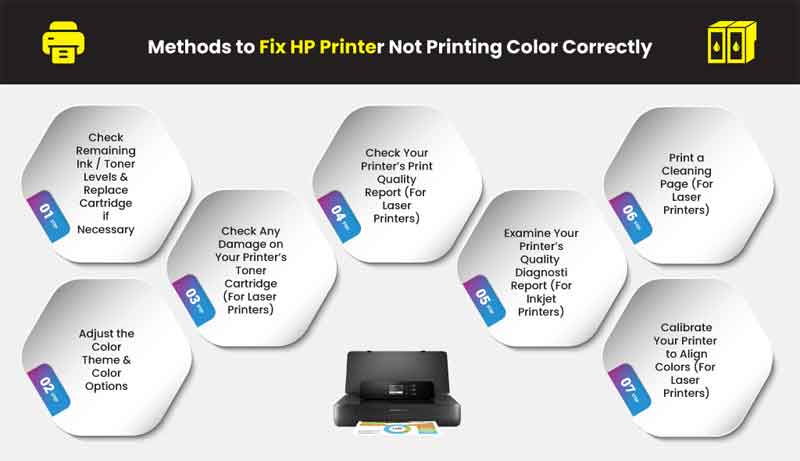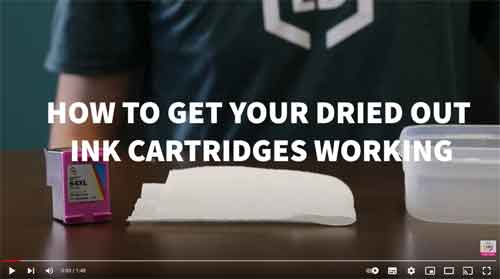Loading…
HP Printer Not Printing | Computer Printing Problems and Solutions
Is your HP printer not printing? It really doesn't matter what printer make or model you have. The fundamentals of how printing works has not really changed throughout the 50 plus years of printing evolution.
It is likely you have a printer in your home, or access to a printer at work, and if your experience is anything like mine, they are fraught with frequent problems. From paper jams and smudged ink, to flashing lights and zero activity after hitting the print button, are likely common experiences we have all shared.
The one thing to bear in mind is that your printer and computer usually try to tell you that there is an issue, and what that issue is. However, there aren't great communicators, so a little interpretation is required on your part, and this is often a sticking point.
Therefore, I thought I would put this article together that describes common printing issues, how to interpret them, and how I would go about fixing them, drawing on my years of experience as an IT technician. I think the solution presented below will help you, regardless of the printer you are having trouble with.
Join The Human Byte — Get The Ultimate BIOS Update Guide
- Receive the ultimate BIOS update pack
- Includes a set of checklists and flowcharts to support your BIOS update process
- Also includes the full set of common FAQs from users who experience BIOS update issues
- Receive regular emails with practical information you can use
- I only use your e-mail for the newsletter. Unsubscribe anytime.
HP Printer Not Printing
Printing Hardware Problems And Resolutions
We start by reviewing key hardware checks you can perform when experiencing printing problems. The approach to troubleshooting is usually to work from the outside in, which means to check your hardware first, before inspecting your software. The depends, of course, on the error message.
What Are The Lights On Your Printer Telling You?
Modern printers come with LCD screens that display messages, but many printers still have the RAG (Red Amber Green) light status for power, ink or toner status, and whether there is any paper in the paper tray. They also have “blinking light routines”, or codes, that can be interpreted into paper jams or mechanical issues, for example.
However, different printers have different lights, and different blinking light routines that means something different between printer makes and even models. No wonder, things are confused, and difficult to interpret what your printing is trying to tell you.
Therefore, my recommendation, and this is what any computer technician would do, is to either search the Internet for the answer, or find your copy of the instruction manual. There is usually a section that explains what the lights, and the symbols next to the lights, are, what their blink patterns mean, and steps to help resolve the problem.
Are Your Printer Cables and Connections Secured?
I have lost count of the times a computer problem is caused by cable connections. Printer power cables, and USB cabling, can come loose without your realizing. They get accidentally and unknowingly knocked, or even unplugged, and forgotten to be plugged back in.
If your printer is not switching on, make sure your power cable is firmly plugged in to the wall, and the printer. Ensure the wall socket is switched on, and any power switches on the printer itself is switched on. Then, check your USB cable is firmly connected at both your computer and printer ends.
There is also the option of reseating your cables, which basically means to unplug or remove, at both ends, then plug back in. This often resolves issues without rhyme or reason.
Today, modern printers have wireless capabilities. However, printing over Wi-Fi in my experience is much less reliable than wired connections. Therefore, my advice is to always connect over a wired connection, if possible. My printers at home are plugged directly in to my home broadband router with Ethernet cables. Best decision I ever made.
The Dreader Paper Jam
Everyone had experienced a paper jam. If you haven't, then you haven't lived! I have experienced the simple paper jam, where the full A4 sized paper is visible in the printing mechanism, and you can simply ease it back out, with no damage done.
I have also experienced the paper jam nightmare, which is usually when fragments of paper are stuck in the printing mechanism that you cannot even see, but are still big enough to trigger the paper jam sensors, or cause your paper to crease, concertina and jam again.
Check your printing manual, so you know which compartments to pull open, or remove, to access the rollers and mechanisms. Modern printers have these instructions on their LCDs, and are easy to follow.
It is worth noting that rollers can become smooth, or covered with a thin dust from your paper. If your rollers are not picking up paper from your paper tray, try cleaning them with the right solution.
Some printers will not clear the error until all of their troubleshooting steps have been fully completed. This frustrates seasoned IT professionals who know what the problem is and how to resolve, but still have to complete all the other tasks.
If all else fails, consider taking your device to a computer repair shop. They often have specialist tools to resolve the issue much more quickly.
Are Your Ink or Toner Cartridges OK?
The first thing to check is that your cartridges are not empty, or nearing empty. Often the cartridges can be lightly shaken to get the last residues out, before the printer permanently senses they are empty.
Remember, to replace with original or genuine cartridges. They cost more, but are more likely to work than 3rd party cartridges, and less likely to smudge.
HP Printer Not Printing
How To Replace A Toner Cartridge Video
Often, the quality of your printed output is affected by clogged printheads, including streaking and fading. Printheads are where your cartridges are housed, and are part of the process for placing ink on your paper. Check your manual for how to clear the printhead on your printer model.
If you have an ink jet printer, you can dab the area where the ink comes out with a wet towel, to clear any debris and dried ink, and essentially unlock the nozzles.
HP Printer Not Printing
How To Get Your Ink Cartridges Working Again Video
Often, printing hardware is the source of a problem, and can often be easily fixed. However, there is plenty that can go wrong with printing software, which we shall look at in more detail next.
HP Printer Not Printing
Printing Software Problems And Resolutions
At this stage, your printing hardware should be confirmed as in full working order. If your HP Printer not printing, still? If you are continuing to have issues, it is time to have a look at the software that manages and controls your printing requests.
Is The Right Printer Selected?
Most people simply select File > Print, or Ctrl + P, and print to whatever the default printer is on your device. This is usually the printer used most often, or even, the only printer available, or in your home.
However, have you checked to make sure the printer you are printing to, is the correct one? The drivers typically display the make and model. If you don't recognize what is presented, select the alternative from the drop-down menu.
In my technician days. I used to remove all other printers on user computers that they did not need. Typically, applications, such as Microsoft Office, install printing options that are not needed by everyday computer users.
By removing these, there was less chance of an incorrect print object being selected, which meant we could all make better use of our time. Win-Win.
Does The Print Queue Look OK?
When you print something, the request is put into the print queue, and from here, is transferred to your printer via the print spooler service. When check print queues, it is also worth including checks of the print spooler.
Open the print queue in Printers & Scanners, and if you see numerous print requests queued up, first check the status of the first print request. If it is queued, ensure the queue is not paused. If there is an error status, clear the queue by highlighting and deleting all the print requests.
Occasionally, the first print request will not clear by deleting. Try powering your printer off and on. If that doesn't clear it, go to Services and check the Print Spooler.
Ensure the spooler service is running. If it is running, but you are still having issues. Stop the spooler, and then start it up again. I prefer not to use the restart option because I want to be sure that the spooler actually stops first. Check the print queue again to see if the stuck request has disappeared. If it hasn't, try deleting again. Once the print queue is cleared, try sending your print request again.
Managing Printer Drivers
When you open the print queue, you have access to other options that help to manage and troubleshoot the drivers.
There are diagnostics tests and checks you can perform, including printing a test page. If this is successful, you can be confident that the end-to-end printing process is working as expected. If it is unsuccessful, i.e. doesn't print at all, and prints with an error message, you know there's an issue, and may have an indication of where the fault lies.
Modern Operating Systems also have a troubleshooter or diagnosis option, which is worth running to get to the source of the problem. It is also worth noting that the management software, that comes with the vendor's device drivers, have additional options, such as calibrating checks, which ensure the printed output is accurate, and nozzle cleaning, which uses the printer's inbuilt cleaning tools to remove blockages.
If you are more technically savvy, you could also check your printer's ports (e.g. check the IP address is correct), and the sharing status if required (e.g. Is the PC the printer is connected to switched on).
It is also worth checking your printer drivers are up-to-date. Older drivers are likely to have bugs that could be causing your issue, and that have been fixed in subsequent releases.
Ensure you use the manufacturer's print drivers, and not the inbuilt Operating Systems. The manufacturer's drivers are, in general, more compatible, and more feature rich, which can be helpful when you need to make advanced tweaks to colour settings, dots per Inch (DPU) and other print quality settings.
That reminds me, you can try removing and re-adding your printer. Occasionally, they are classed as offline, and the status cannot be changed regardless of what you do. If all else fails, remove and reinstall the printer drivers.
HP Printer Not Printing | Final Thoughts
Is your HP printing not printing, still? I hope after the advice in this article you are some way to resolving your problems.
I come across the diagram below, which, I think, is a good reference point for how to approach colour printing issues. Furthermore, I know how important it is to some for the colours on the printing output, to be the same shade as what is displayed on screen. It is also a good reference point for troubleshooting issues covered in this article.
 HP Printer Not Printing
HP Printer Not PrintingLogical Steps To Troubleshooting Printing Problems
Source:- yoyoink.com
Finally, there are some excellent articles online that can help resolve printing problems. Have a look at the links below for further details:-
- HP Printer Not Printing — What To Do When Your Printer Won't Print
- HP Printer Not Printing — How To Fix Common Printer Problems
- HP Printer Not Printing — Official HP Site Support
Was this page helpful?
Thanks! ✅

